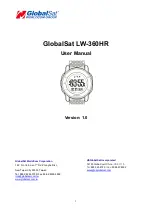
your position is our focus
External
data
source,
e.g.
wireless
network
operator
Almanac
Ephemeris
Coarse Position
Coarse Time
Precise Time
Synchronization
Pulse
Cold Start
Improved to
Improved to
typ 34 s
typ 24 s
typ 4-12 s
Figu
g Principal
lse”
if
the
option
hardware
time
synchronization
pulse
is
desired.
3.
Apply
optional
hardware
time
synchronization
pulse
within
0.5s
after
sending
the
AID-INI
message
if
hardware
time
snyconization
is
required.
Before
applying
the
time
pulse,
allow
the
GPS
receiver
to
parse
and
process
the
AID-HUI
message.
The
time
for
parsing
depends
on
the
baudrate.
The
processing
time
is
100ms
maximum.
4.
Send
optional
UBX-AID-HUI
(health,
UTC
and
ionosphere
parameters)
message
5.
Send
optional
UBX-AID-ALM
(almanac)
message
UBX Aiding messages
re 75: Aidin
Aiding Sequence
1.
Send
UBX-AID-EPH
(ephemeris)
message
2.
Send
UBX-AID-INI
(time,
clock
and
position)
message.
Do
not
forget
to
set
the
‘Accurate
time
is
input
with
time
pu
Message
Description
AID-REQ
Virtual
Aiding
configuration
message
to
enable
aiding
request
at
startup.
If
this
message
is
enabled,
the
Aiding
Client
will
automatically
poll
aiding
data
from
an
Aiding
Server
with
an
AID-DATA
message
in
case
of
a
cold
start.
AID-DATA
Polls
all
GPS
Initial
Aiding
Data
AID-INI
Contains
position,
time,
clock
drift
and
validation
parameters
of
the
aiding
data.
AID-HUI
Contains
health
bit
mask,
UTC
time
and
Klobuchar
parameters.
This
message
is
not
required
to
achieve
a
good
TTFF,
but
it
helps
to
achieve
good
position
accuracy
and
to
correct
the
UTC
offset.
AID-ALM
Contains
the
almanac
data
of
one
SV.
AID-EPH
Contains
the
ephemeris
data
of
one
SV.
Table 26: Aiding messages
For
further
information
about
the
UBX
aiding
messages,
refer
to
the
ANTARIS
®
4
Protocol Specifications [9]
.
GPS
Modules
-
System
Integration
Manual
(SIM)
(incl.
Reference
Design)
Receiver
Description
GPS.G4-MS4-05007-A1
Page 91
















































